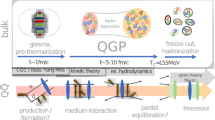Abstract
The origin of quark–hadron duality violations (DVs) can be related to the singularities of the Laplace transform of the spectral function. With the help of rather generic properties of the large-\(N_c\) approximation and a generalized form for the radial trajectories found in Regge Theory, we may locate these singularities in the complex plane and obtain an expression for the DVs which turns out to agree with general expectations. Using the two-point vector correlator as a test laboratory, we show how the usual dispersion relation may give rise to perturbation theory, the power corrections from the condensate expansion and DVs.


Similar content being viewed by others
Notes
In what follows, we will consider the perturbative expansion as the OPE contribution from the unit operator.
We will simplify our world by taking the chiral limit.
For simplicity, we are normalizing the parton model contribution to unity.
Even if we consider the log corrections in the \(b_n\) coefficients, at high enough \(q^2\), a finite number of these power corrections cannot give rise to the oscillations commonly seen in the spectral data.
In fact, to fulfill the reality property \(\mathcal {A}({q^2}^*)=\mathcal {A}(q^2)^*\), one should rotate \(\sigma \) clockwise for \(\mathrm {Im}\, q^2>0\) and anti-clockwise for \(\mathrm {Im}\, q^2<0\).
We will assume that \(e^{\sigma q^2}\sigma \, \mathcal {B}^{[\rho ]}(\sigma )\) always falls off for to zero for \(|q^2|\rightarrow \infty \).
In this context, \(N_c=3\) is large enough.
We will use these units for the rest of this article.
This expression says that perturbation theory is the part of the large-\(q^2\) expansion which depends solely on powers of \(\log (-q^2)\).
Recall that our momentum is in units of \(\Lambda _{QCD}\).
References
See, e.g., S. Peris, M. Perrottet, E. de Rafael, JHEP 05, 011 (1998). https://doi.org/10.1088/1126-6708/1998/05/011. arXiv:hep-ph/9805442 [hep-ph]
M.A. Shifman, Int. J. Mod. Phys. A 11, 3195 (1996). arXiv:hep-ph/9511469
B. Blok, M.A. Shifman, D.X. Zhang, Phys. Rev. D 57, 2691 (1998). https://doi.org/10.1103/PhysRevD.57.2691, https://doi.org/10.1103/PhysRevD.59.019901. arXiv:hep-ph/9709333 [Erratum: Phys. Rev. D 59, 019901 (1999)]
M.A. Shifman, in At the frontier of particle physics, vol. 3 (World Scientific, 2001), pp. 1447–1494. arXiv:hep-ph/0009131
E.C. Poggio, H.R. Quinn, S. Weinberg, Phys. Rev. D 13, 1958 (1976). https://doi.org/10.1103/PhysRevD.13.1958
M. Shifman, eConf C030614, 001 (2003) (WQCD-2003-001, and references therein)
D. Boito, I. Caprini, M. Golterman, K. Maltman, S. Peris, Phys. Rev. D 97(5), 054007 (2018). https://doi.org/10.1103/PhysRevD.97.054007. arXiv:1711.10316 [hep-ph]
See, for example, I. Aniceto, G. Basar, R. Schiappa, Phys. Rept. 809, 1–135 (2019). https://doi.org/10.1016/j.physrep.2019.02.003. arXiv:1802.10441 [hep-th]
T.M. Seara, D. Sauzin, Resumació de Borel i Teoria de la Ressurgencia (in Catalan). Butll. Soc. Catalana Mat. 18, 129 (2003)
B. Candelpergher et al., Approche de la résurgence, Actualités Mathématiques. Hermann edit., in particular section “Commentaire 1: Sommation de Borel.” For a rather exhaustive treatise, see O. Costin, Asymptotics and Borel Summability. Chapman and Hall, CRC, Boca Raton (1993) (in particular, section 4.4d)
G.t. Hooft, Nucl. Phys. B 75, 461 (1974)
C.G. Callan Jr., N. Coote, D.J. Gross, Phys. Rev. D 13, 1649 (1976)
See, for example, M. Shifman, A. Vainshtein, Phys. Rev. D 77, 034002 (2008). arXiv:0710.0863 [hep-ph] (and references therein)
See, for example, P. Masjuan, E. Ruiz Arriola, W. Broniowski, Phys. Rev. D 85, 094006 (2012). arXiv:1203.4782 [hep-ph]
V.A. Fateev, S.L. Lukyanov, A.B. Zamolodchikov, J. Phys. A 42, 304012 (2009). arXiv:0905.2280 [hep-th]
P. Flajolet et al., Theor. Comput. Sci. 144, 3 (1995)
See, for example, G.H. Hardy, M. Riesz, The General Theory of Dirichlet’s Series, Cambridge Tracts in Mathematics and Mathematical Physics (Cambridge University Press, 1915). A useful summary can be found in https://en.wikipedia.org/wiki/General_Dirichlet_series, https://en.wikipedia.org/wiki/Dirichlet_series
E. de Rafael, Nucl. Phys. Proc. Suppl. 207–208, 290 (2010). arXiv:1010.4657 [hep-th]
D. Boito, M. Jamin, R. Miravitllas, Phys. Rev. Lett. 117(15), 152001 (2016). https://doi.org/10.1103/PhysRevLett.117.152001. arXiv:1606.06175 [hep-ph]
L.S. Brown, L.G. Yaffe, C.X. Zhai, Phys. Rev. D 46, 4712 (1992). https://doi.org/10.1103/PhysRevD.46.4712. arXiv:hep-ph/9205213
G. ’t Hooft, Nucl. Phys. B 72, 461 (1974) [B73 (1974) 461]
E. Witten, Nucl. Phys. B 79, 57 (1979)
O. Catà, M. Golterman, S. Peris, JHEP 0508, 076 (2005). arXiv:hep-ph/0506004
O. Catà, M. Golterman, S. Peris, Phys. Rev. D 77, 093006 (2008). arXiv:0803.0246 [hep-ph]
D. Boito, O. Catà, M. Golterman, M. Jamin, K. Maltman, J. Osborne, S. Peris, Phys. Rev. D 84, 113006 (2011). arXiv:1110.1127 [hep-ph]
D. Boito, M. Golterman, M. Jamin, A. Mahdavi, K. Maltman, J. Osborne, S. Peris, Phys. Rev. D 85, 093015 (2012). arXiv:1203.3146 [hep-ph]
D. Boito, M. Golterman, K. Maltman, J. Osborne, S. Peris, Phys. Rev. D 91, 034003 (2015). arxiv:1410.3528 [hep-ph]
D. Boito, M. Golterman, K. Maltman, S. Peris, M. V. Rodrigues, W. Schaaf, Phys. Rev. D 103(3), 034028 (2021). https://doi.org/10.1103/PhysRevD.103.034028. arXiv:2012.10440 [hep-ph]
Acknowledgements
I am very grateful to D. Boito, I. Caprini, M. Golterman and K. Maltman for innumerable discussions on DVs and a pleasant collaboration. Work supported by CICYTFEDER-FPA2017-86989-P and by Grant No. 2017 SGR 1069. IFAE is partially funded by the CERCA program of the Generalitat de Catalunya.
Author information
Authors and Affiliations
Corresponding author
Rights and permissions
About this article
Cite this article
Peris, S. Violation of quark–hadron duality. Eur. Phys. J. Spec. Top. 230, 2691–2698 (2021). https://doi.org/10.1140/epjs/s11734-021-00255-1
Received:
Accepted:
Published:
Issue Date:
DOI: https://doi.org/10.1140/epjs/s11734-021-00255-1



